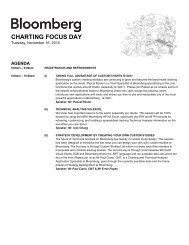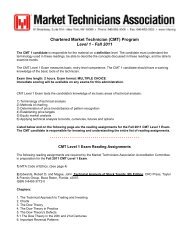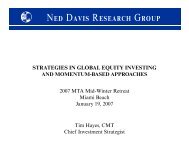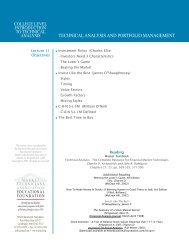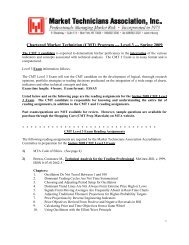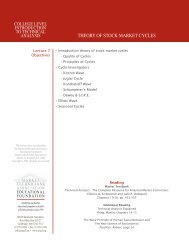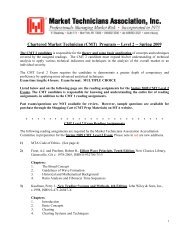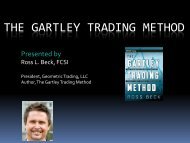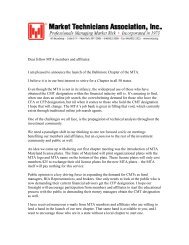Journal of Technical Analysis - Market Technicians Association
Journal of Technical Analysis - Market Technicians Association
Journal of Technical Analysis - Market Technicians Association
You also want an ePaper? Increase the reach of your titles
YUMPU automatically turns print PDFs into web optimized ePapers that Google loves.
30<br />
Annualized performance <strong>of</strong> the trading strategies was assessed by applying the real trades over the five year period to a Monte Carlo analysis for 260 days,<br />
an approximate trading year. In each case the Monte Carlo analysis used 10,000 iterations, simulating nearly 40 years <strong>of</strong> trading. S<strong>of</strong>tware to do this analysis was<br />
MCSPro 3 by Inside Edge Systems. Due to the central limit theorem, the probability distribution <strong>of</strong> annual pr<strong>of</strong>it has a Normal Distribution and the Drawdown has a<br />
Rayleigh Distribution. While the Monte Carlo analysis reveals the most likely annual pr<strong>of</strong>its and drawdowns, it can also assess the probability <strong>of</strong> breakeven or better.<br />
Furthermore, one can make a comparative reward/risk ratio by dividing the most likely annual pr<strong>of</strong>it by the most likely annual drawdown. One can also evaluate the<br />
amount <strong>of</strong> tolerable risk and required capitalization in small accounts from the size <strong>of</strong> the two or three sigma points in the drawdown.<br />
The Monte Carlo results for the Channel strategy are shown in Figure 8. The most likely annual pr<strong>of</strong>it is $11,650 and the most likely maximum drawdown is<br />
$7,647 for a reward to risk ratio <strong>of</strong> 1.52. The Channel strategy has an 88.3% chance <strong>of</strong> break even or better on an annualized basis.<br />
The Monte Carlo results for the RSI strategy are shown in Figure 9. The most likely annual pr<strong>of</strong>it is $17,085 and the most likely maximum drawdown is $6,219.<br />
Since the pr<strong>of</strong>it is higher and the drawdown is lower than for the Channel strategy, the reward to risk ratio is much larger at 2.75. The RSI strategy also has a better<br />
96.6% chance <strong>of</strong> break even or better on an annualized basis.<br />
The Monte Carlo results for the Fisher strategy are shown in Figure 10. The most likely annual pr<strong>of</strong>it is $16,590 and the most likely maximum drawdown is<br />
$6,476. The reward to risk ratio <strong>of</strong> 2.56 is about the same as for the RSI strategy. The Fisher Transform strategy also has about the same chance <strong>of</strong> break even or<br />
better at 96.1%.<br />
These studies show that the three trading strategies are robust across time and <strong>of</strong>fer comparable performance when applied to a common symbol. To further<br />
demonstrate robustness across time as well as applying to a completely different symbol, performance was evaluated on the S&P Futures, using the continuous<br />
contract from its inception in 1982. In this case, we show the equity curve produced by trading a single contract without compounding. There is no allowance for<br />
3 MCSPro, Inside Edge Systems, Bill Brower, 200 Broad St., Stamford, CT 06901<br />
Jo u r n a l <strong>of</strong> <strong>Technical</strong> <strong>Analysis</strong> • 2008 • Issue 65




